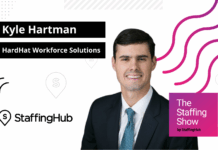
By Laura Schmitz, VP of Operations, Aqore Staffing Software
Key Takeaways:
- Technology alone doesn’t improve business outcomes — it must be properly aligned with operational processes to be effective. Many businesses fail by trying to force new software onto outdated workflows.
- Before implementing new technology, companies should critically examine and refine their existing processes by identifying inefficiencies, redundancies, and opportunities for automation.
- Success requires a comprehensive strategy that includes documenting current workflows, selecting appropriate technology solutions, providing thorough staff training, ensuring strong change management with internal champions, and using data analytics to continuously optimize processes.
In the fast-paced world of staffing, we all know that success is not just about filling job orders — it’s about efficiency, accuracy, and creating an experience that benefits both clients and candidates. As the industry becomes increasingly technology-driven, businesses that fail to align their processes with their technology risk falling behind. The most successful staffing agencies understand that technology isn’t just a tool; it’s a strategic enabler that must be integrated seamlessly with business operations to drive results.
The disconnect between process and technology
Through my experience consulting with many businesses in all industries and on a variety of technology tools, I have been asked to rescue time and again investments made in cutting-edge software solutions that haven’t improved productivity and efficiency. Why? Because technology alone does not solve problems — process alignment does. When businesses attempt to force new technology onto outdated workflows, inefficiencies multiply, leading to frustration for the team, longer hiring cycles, and lost revenue.
Common signs of a misalignment between process and technology include:
- Redundant data entry and manual workarounds, secret spreadsheets reign
- Inefficient communication between you and your clients
- Low adoption rates of tool features and functionality
- Lack of visibility into key performance metrics
- Compliance risks due to inconsistent processes
The reality is that technology should support and enhance your operation — not complicate it.
Challenging existing processes for better outcomes
One of the biggest mistakes businesses make is assuming that current processes are optimal. Before implementing new technology, businesses should challenge their existing workflows to identify areas for improvement.
Questions to ask include:
- Are there redundant steps that technology can eliminate?
- Are you using automation to its fullest potential?
- Does your team spend too much time on administrative tasks rather than engaging with clients and candidates?
- How many spreadsheets are being used? Are they able to produce the metrics you rely on for your business at a moment’s notice?
By proactively questioning and refining processes, businesses can better leverage technology to enhance efficiency and effectiveness. And make no mistake, this shouldn’t be a one time exercise, it should be repeated quarterly or annually to ensure what you’re expecting is truly what’s happening.
Building a strategy for alignment
Aligning process with technology starts with a clear strategy. Here’s how businesses can ensure that their digital investments drive real results:
1. Evaluate and document your current workflow
Before implementing new technology, agencies must map out their existing processes. This means identifying every step and tool involved in sales, sourcing, screening, onboarding, collecting time, paying and placing candidates. By understanding current inefficiencies, you can determine where automation and technology can create the most impact.
2. Select technology that improves your process
Too often, businesses choose software based on features rather than their actual needs. A well-aligned technology solution should:
- Streamline candidate sourcing and onboarding.
- Integrate with existing systems and processes (such as payroll, compliance tools, and CRM). Too many Add-Ons can compete or even detract from efficiency and efficacy with the tool and process.
- Automate repetitive tasks to free up your team’s time.
- Offer real-time insights into key performance indicators.
3. Train and empower your team
Even the best software is useless if your team doesn’t know how to use it effectively. Proper training ensures that everyone can fully leverage the system’s capabilities, improving both efficiency and user adoption. Investing in training and maintenance training also helps bridge the gap between technology and human expertise.
4. Management and internal championship
Successfully adopting new technology requires strong change management and championship within the organization. Leadership must actively advocate for the technology and demonstrate its value. Without buy-in from key stakeholders, even the best tools can fail to make an impact.
Strategies for effective change management include:
- Appointing internal champions to drive adoption and advocate for process improvements.
- Providing ongoing training and support.
- Creating feedback loops to refine processes based on user experience.
- Monitor and assess usage and outcomes based on your original goals and once met, create new ones.
5. Use data to continuously optimize
Modern staffing software provides valuable analytics that can help agencies refine their processes over time. By leveraging data on placement success rates, time-to-fill, and candidate retention, client engagement and so on, staffing agencies can make informed decisions to improve performance.
Build a competitive advantage through alignment
In today’s staffing landscape, businesses that align process with technology gain a significant competitive edge. The right technology, when integrated into a well-structured process, enables businesses to operate more efficiently, deliver better experiences, and drive long-term success.
 Laura Schmitz is a strategic leader in staffing technology, driving innovation in her role as VP of Operations with Aqore Staffing Software. She excels in software transition, client success, and process optimization. Passionate about team growth and industry impact, she shares expertise at conferences and thrives on delivering results while building strong partnerships.
Laura Schmitz is a strategic leader in staffing technology, driving innovation in her role as VP of Operations with Aqore Staffing Software. She excels in software transition, client success, and process optimization. Passionate about team growth and industry impact, she shares expertise at conferences and thrives on delivering results while building strong partnerships.





